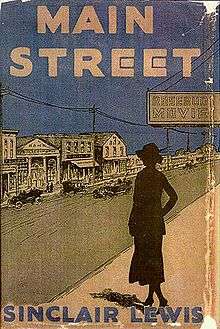Main Street (novel)
 First edition | |
| Author | Sinclair Lewis |
|---|---|
| Country | United States |
| Language | English |
| Publisher | Harcourt, Brace and Howe |
Publication date | 1920 |
| Media type | Print (hardback & paperback), and audiobook |
| Pages | 448 pages |
| ISBN | 1420930923 |
Main Street is a satirical novel written by Sinclair Lewis, and published in 1920.
Plot summary
Carol Milford, the daughter of a judge, grew up in Mankato, Minnesota and became an orphan in her teens. In college, she reads a book on village improvement in a sociology class and begins to dream of redesigning villages and towns. After college, she attends a library school in Chicago and is exposed to radical ideas and lifestyles. She becomes a librarian in Saint Paul, Minnesota, the state capital, but finds the work unrewarding. She marries Will Kennicott, a doctor, who is a small-town boy at heart.
When they marry, Will convinces her to live in his home-town of Gopher Prairie, Minnesota, a town modeled on Sauk Centre, Minnesota, the author's birthplace. Carol immediately sets about her plans to remake Gopher Prairie. But she is filled with disdain for the town's physical ugliness and smug conservatism.
She speaks with its members about progressive changes, joins women's clubs, distributes literature, and holds a party to liven up Gopher Prairie's inhabitants. Despite her ineffective efforts, she is constantly derided by the leading cliques.
She finds comfort and companionship with a variety of social outsiders in the town, but these companions all fail to live up to her expectations.
After a political meeting of the Nonpartisan League is broken up by local authorities, Carol leaves her husband and moves for a time to Washington, D.C., to become a clerk in a wartime government agency. She eventually returns. Nevertheless, Carol does not feel defeated:
I do not admit that Main Street is as beautiful as it should be! I do not admit that Gopher Prairie is greater or more generous than Europe! I do not admit that dish-washing is enough to satisfy all women! I may not have fought the good fight, but I have kept the faith. (Chapter 39)
Literary significance and criticism
Some of Lewis's contemporaries said the novel was too bleak, even humorless, in its conveyance of ignorant small-town life and people.[1] However, Main Street is generally considered to be Lewis's most significant and enduring work, along with its 1922 successor Babbitt.[2]
Some small-town residents resented their portrayal and the book was banned by the public library of Alexandria, Minnesota.[3]
Because of the popularity acquired by Lewis and his book, high-school teams from his hometown of Sauk Centre, Minnesota, began to be called the Main Streeters as early as the 1925–26 school year. This name was essentially given to the town by the nearby towns at school events.[4] The Sauk Centre High School still goes by the name in a tribute to Lewis.
Allusions/references to history, geography and culture
The story is set in Gopher Prairie, Minnesota, a fictionalized version of Sauk Centre, Minnesota, Lewis's hometown. The novel takes place in the 1910s, with references to the start of World War I, the United States' entry into the war, and the years following the end of the war, including the start of Prohibition.
Awards and nominations
Main Street was initially awarded the 1921 Pulitzer Prize for literature, but was rejected by the Board of Trustees, who overturned the jury's decision. The prize went, instead, to Edith Wharton for The Age of Innocence. In 1926 Lewis refused the Pulitzer when he was awarded it for Arrowsmith.
In 1930, Lewis was the first American ever awarded the Nobel Prize in Literature. While a Nobel Prize is awarded to the author not the work, and itself does not cite a particular work for which he was chosen, Main Street was Lewis' best-known work and enormously popular at the time. In the Nobel committee's presentation speech, both Main Street and Arrowsmith were cited.[5] The prize was awarded "...for his vigorous and graphic art of description and his ability to create, with wit and humour, new types of characters."[6]
In 1998, the Modern Library ranked Main Street #68 on its list of the 100 best English-language novels of the 20th century.
See also
- Main Street — the iconic street in small town America
Notes
- ↑ Anaïs Nin, The Early Diary of, 1982, Harcourt Brace Jovanovich (This author disliked the book herself and cited a review by Cathrin Beach Ely that agreed with her.)
- ↑ Gore, Vidal (8 October 1992). "The Romance of Sinclair Lewis: Main Street and Babbitt". The New York Review of Books. Retrieved 26 August 2015.
- ↑ Dregni, Eric (2006). Weird Minnesota: Your Travel Guide to Minnesota's Local Legends and Best Kept Secrets. Sterling Publishing Company, Inc. p. 61. ISBN 9781402739088.
- ↑ Gilbert, Rosalind (2000). Our Century: Revisiting Sauk Centre. p. 77.
- ↑ "The Nobel Prize in Literature 1930; Sinclair Lewis — Presentation Speech". NobelPrize.org. The Nobel Foundation. 1930-12-10. Retrieved 2011-09-12.
- ↑ "The Nobel Prize in Literature 1930; Sinclair Lewis". NobelPrize.org. The Nobel Foundation. 1930. Retrieved 2011-09-12.
External links
| Wikisource has original text related to this article: |
- Main Street at Project Gutenberg
